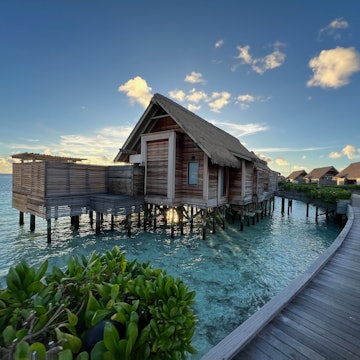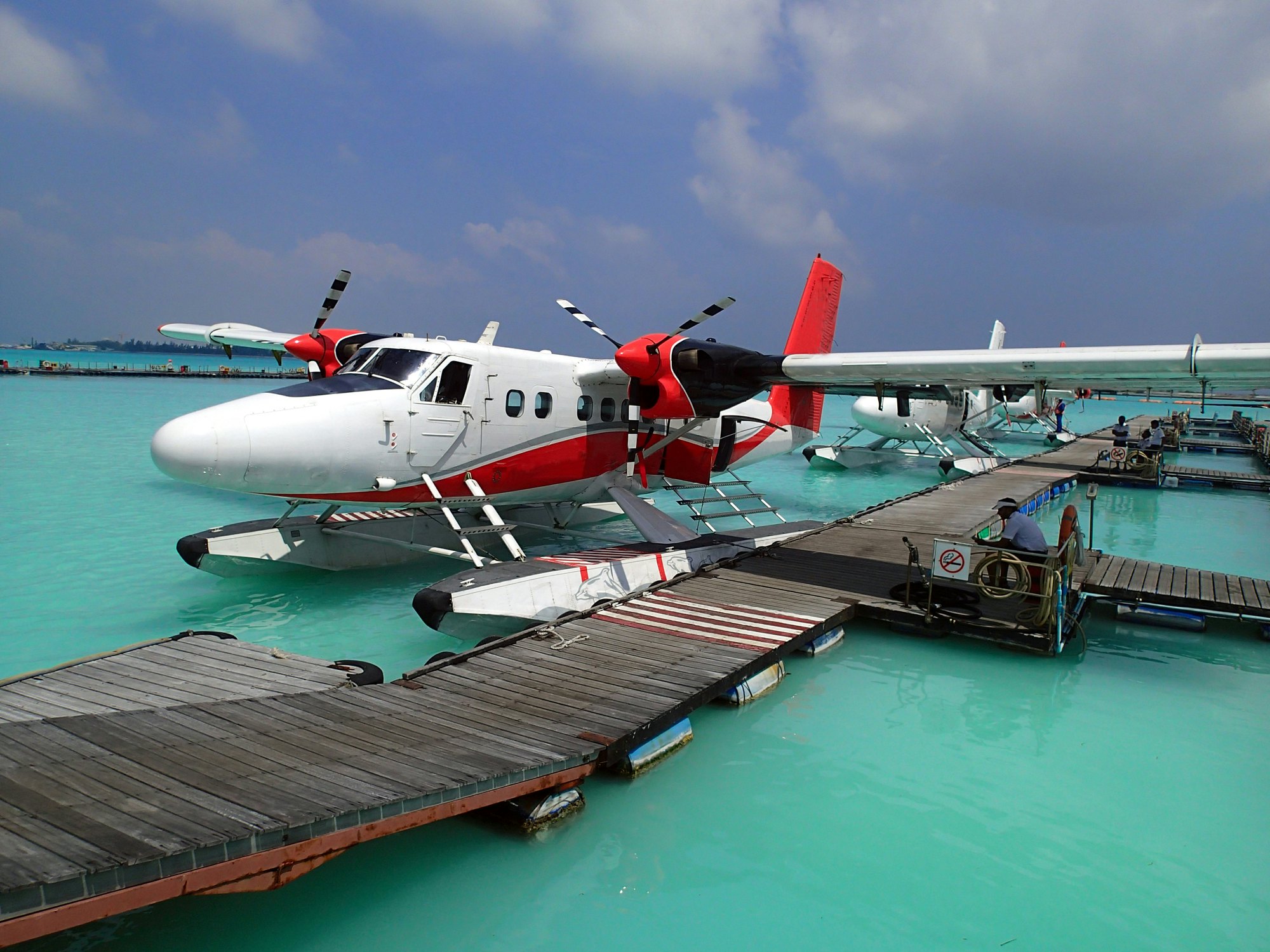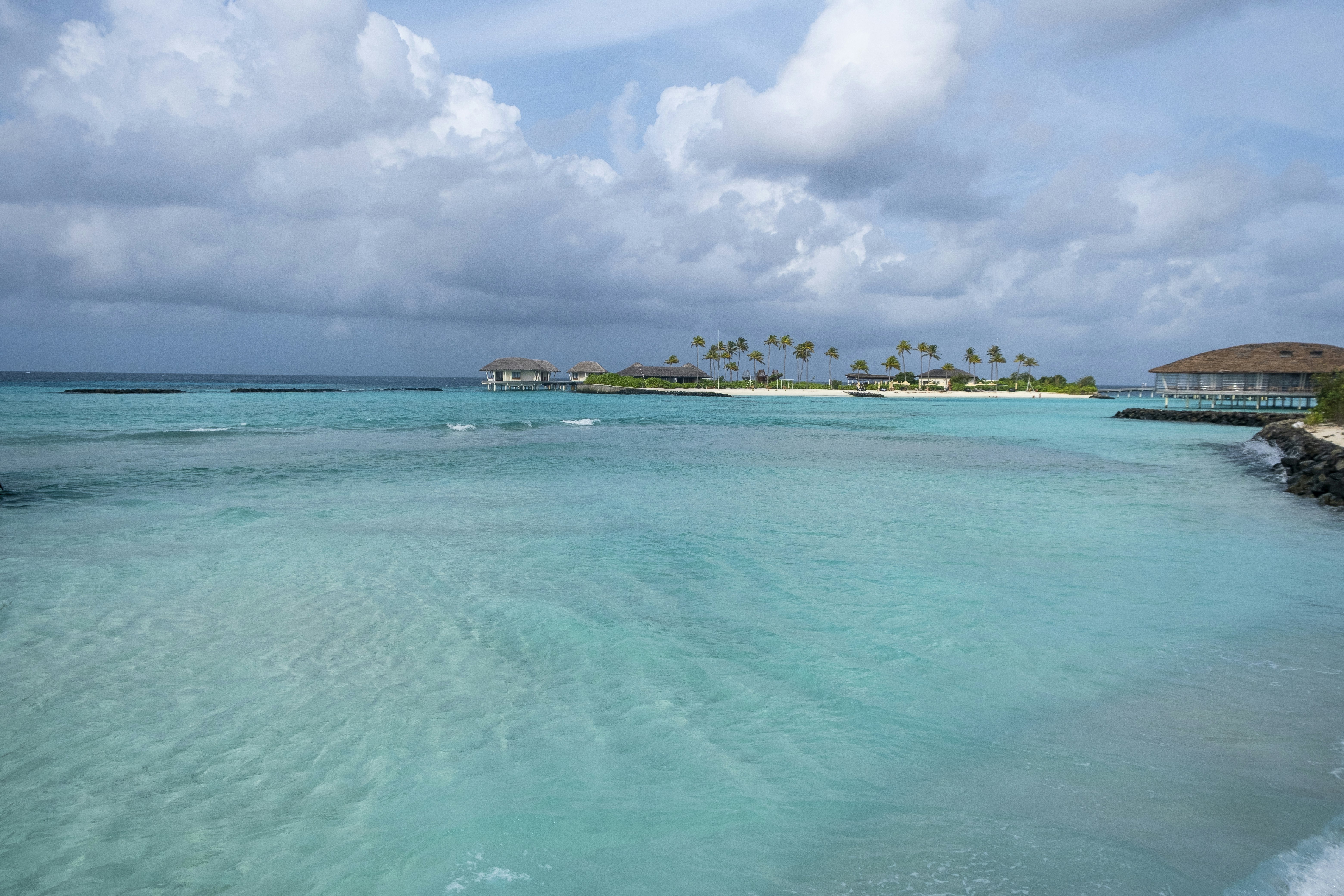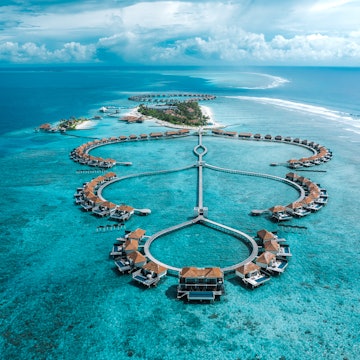

A sea plane in the Maldives. Jag_cz/Getty Images
With palm-fringed white sand beaches and crystal-clear waters home to turtles, manta rays, dolphins and whale sharks, the Maldives offers a tropical beach vacation coupled with exceptional snorkeling and diving experiences. Stargazers will particularly love the remote islands surrounded by the expansive ocean with little to no light pollution.
The archipelagic nation in the Indian Ocean consists of nearly 1200 scattered islands with coral reefs, grouped into 26 atolls, with only about 200 islands that are inhabited.
While most tourists head to one or two luxury private resort islands with overwater villas during their vacation, many local islands now have guesthouses and boutique hotels (as well as dedicated beach strips where visitors can slip into their swimwear), making the Maldives a destination for travelers of all budgets. These local island trips are particularly rewarding for a glimpse into local culture, where you’ll begin your day with a plate of mas huni, a traditional Maldivian breakfast made of tuna, coconut, onions and a sprinkle of lime juice, paired with freshly baked roshi (flatbread).
Most visitors will likely land at the Velana International Airport, from where you can head to the capital, Male, or hop on a seaplane, ferry, speedboat, or a domestic flight to continue your island getaway. Here’s our guide to getting around the Maldives.

Using ferries to get around the Maldives
Get on the traditional public ferry for a slow, local experience
Ask any Maldivian and they’ll tell you stories of their childhood, traveling to far-flung islands on day and overnight ferries, eating, lounging and spending time together with families. The regular ferries are slow (a 30-minute speedboat journey may take an hour and a half on the ferry), but they are an excellent way to experience the vibrant rhythm of local Dhivehi life and save money.
A 90-minute ferry journey is around 45 Maldivian rufiya (r), white longer journeys can cost up to 459r, depending on the length of the route, which is significantly cheaper than most other transport options. Government-operated ferries link the capital Male with several local islands; ferries also run from one island to another in the same atoll and other atolls (inter-atoll routes). Keep in mind that ferries only run to local islands and don’t stop at private resort islands. Being surrounded by the Indian Ocean also means that the weather and sea currents are always unpredictable, leading to sudden cancellations or delays.
Local tip: The ferry routes are available online on Atoll Transfer. You can only book these regular ferry tickets in person with cash - US dollars (US$) are often accepted - either at the ferry counter in Male, or via your accommodation.
Island-hop on a fast ferry
As part of the national high-speed ferry network, the government-run Raajje Transport Link (RTL) ferries – faster than the usual public ferry – connect local islands in some atolls (building this nationwide ferry route is still underway). A popular choice among residents now, they are ideal for remote atoll explorations, like the Haa Alif, the northernmost atoll in the Maldives. Based on your journey, tickets cost anywhere between 35–125r for a one-way trip. The 48-seat vessels are fiberglass, with air conditioning, toilets and wheelchair access. Route maps, schedules, and tickets are available on the RTL website.
Take the airport ferry to explore Male
The Velana International Airport is the main gateway to the Maldives, and is located on the airport island of Hulhule, near the capital island of Male. The country’s administrative and economic hub, Male, is densely populated, packed inch to inch with high risers, colorful mosques and markets. It can often be used as a base for independent travel in the Maldives, but it’s also worth exploring for those curious about the way of life in a country that’s mostly only known to the world as a luxury destination. To get here, board a ferry from the airport ferry terminal. They run every 10-15 minutes.

Taking speedboats around the Maldives
Zip around the Maldivian islands in a public speedboat
For both locals and tourists, speedboats are a popular, faster way to get around, especially if they are heading to nearby islands from Male. Prices vary depending on the journey. The 45-minute, one-way speedboat journey to Maafushi, a popular local island with guesthouses for tourists, for example, costs about US$25. The easiest way to book them is through your hotel or guesthouse.
Cruise the waters in complete privacy and comfort
Resort islands and hotels can also organize private speedboat journeys, and the fee is usually added to your package when you book your holiday with them. These vessels set you up for a comfortable journey: expect spacious and comfortable lounging with food and drink. Bonus: you may also get to spot pods of dolphins from the deck.

Seaplanes to zip around the Maldives
Gaze at the atolls from above during a seaplane flight
A seaplane transfer in the Maldives is on everyone’s bucket list, and it’s easy to see why. The views are otherworldly: the endless nothingness of the ocean in cyan, turquoise and deep blues; hundreds of small ring-shaped islets surrounded by coral reefs and mangroves; and scattered inhabited islands appearing, disappearing, and reappearing.
Seaplanes are also the fastest way to get to your resort in the Maldives. The two main privately owned seaplane charters, Trans Maldivian and Manta Air, connect Male with private resort islands. A roundtrip transfer typically costs US$300-900 based on your destination.
These seaplanes depart from a dedicated seaplane terminal, located separately from the international airport. Once you land at Velana International Airport, a representative from your resort takes care of the transfer to the seaplane terminal, which also houses lounges of some of the top luxury resorts (you can treat yourself to snacks, drinks and even a full meal here) and boarding gates with waiting areas. Top-end luxury resorts like Soneva, Joali and Anantara also have their own seaplanes for private transfers.
Tip for traveling on a seaplane in the Maldives: it can feel quite cramped inside a seaplane with 10-15 people in a small space. It can also get hot (most regular seaplanes don’t have air conditioning), and it’s always noisy – earbuds are provided, but carry a pair of noise-cancelling headphones if you’re very sensitive to sound. The rides are sometimes a bit bumpy, so if you’re prone to motion sickness and sea sickness, consult your doctor before your journey.
Internal flights in the Maldives
Save money by boarding a domestic flight
The Maldives is home to five international airports and 13 domestic airports, which are crucial for locals living in faraway islands. Several airlines, like Maldivian, Villa Air and Manta Air, operate flights to domestic airports, which are often cheaper than seaplane charters. If your resort sits closer to a domestic airport, it’s a great way to cut down on expenses. While domestic flights are also an efficient way to get to local islands located far away from Male, ferries remain a more sustainable way to travel in the Maldives. If you’re flying into a domestic airport, however, consider hopping on a quick speedboat ride to get to your resort or nearby local islands. The easiest way to organize this is through your hotel or guesthouse.

How to get around an island in the Maldives?
Most islands are so small that you’ll likely be able to walk the entire length of it. Typically, resorts also have cycles for guests and staff-driven buggy rides to get anywhere within the island. If you’re on a local island, some guesthouses have cycles for free or for rent. With little to no traffic, riding a bicycle is a fun way to experience small islands.
Is there Uber in Male?
While Uber isn’t here, there are several local ride-hailing services like Avas Ride available for trips within Male and nearby areas of the airport island.
Are there public buses in the Maldives?
In recent years, the government-run Maldives Transport and Contracting Company (MTCC) has worked to provide greater connectivity in the Maldives. Part of the Raajje Transport Link (RTL) initiative is the public buses in Male and other major hubs like Addu, a city in the archipelago’s southernmost atoll. There are also buses running from Male to the airport and back. Bus routes are available online on the RTL website. You can buy your ticket online, on the mobile app, or pay with cash. For now, tap to pay contactless card payments are only accepted in buses in Male and the nearby areas, known as the Greater Male Area.
How can I organize excursions in the Maldives?
There are plenty of ways to do this. Resorts, hotels, and guesthouses organize excursions like dolphin watching trips, sunset cruises in a dhoni (a traditional Maldivian fishing vessel) or a speedboat, and trips to other nearby islands. Some resort islands also offer private yacht trips. Liveboarding (a boat with accommodation) trips – ranging from a few nights to weeks – are popular for divers, and are an excellent way to explore marine life in some of the world’s remotest atolls. There are also small cruises, like the G Adventures 7-day journey on a dhoni, or the Intrepid’s 8-day group trips.
Accessible transportation in the Maldives
For visitors with disabilities and mobility needs, traveling in the Maldives can be challenging. The airport only has a few air bridges, and using stairs to embark or disembark the plane is common. The Velana International Airport, however, can provide special assistance to those with mobility needs, so contact your airline before you travel.
Owning or keeping a dog is banned in the Maldives, ruling out having guide dogs during your travels. While it can be tricky to navigate ferries, speedboats and seaplanes, more and more resorts now have better inclusivity and accessibility. Places to check out include Amilla Maldives, which has wheelchair-friendly villas, accessible showers, beach wheelchairs and floating wheelchairs for swimming, while offering adaptive yoga classes, and excursions and dive courses with accessible features. The resorts can also provide airport assistance to guests with movement and visual disabilities.
















